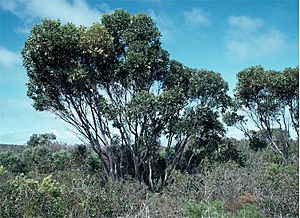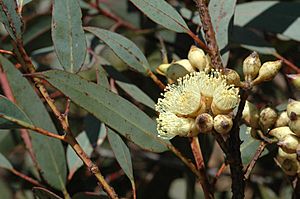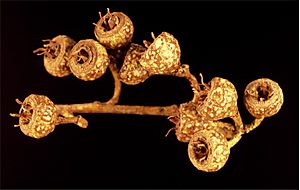Eucalyptus semiglobosa facts for kids
Quick facts for kids Eucalyptus semiglobosa |
|
|---|---|
 |
|
| Eucalyptus semiglobosa at Cape Le Grand National Park | |
| Scientific classification | |
| Genus: |
Eucalyptus
|
| Species: |
semiglobosa
|
| Synonyms | |
|
|
Eucalyptus semiglobosa is a special type of plant that grows as a mallee (a shrubby tree with many stems) or a small tree. It is found only in a specific area along the south coast of Western Australia. This plant has smooth bark, leaves shaped like wide spears, and its flower buds grow in groups of seven. When it blooms, it has creamy white flowers. After the flowers, it produces fruits that are ribbed or wrinkled and look like short, half-spheres.
What it Looks Like
Eucalyptus semiglobosa usually grows as a shrub about 2 meters (about 6.5 feet) tall. It can also be a mallee, reaching up to 5 meters (about 16 feet) in height. It has a special woody swelling at its base called a lignotuber. This helps the plant regrow after a fire.
Its bark is smooth and can be grey or light brown. Young plants and new shoots have square-shaped stems. Their leaves are green on both sides, shaped like an ellipse or an egg, and measure between 20 to 105 millimeters long and 10 to 60 millimeters wide.
Adult leaves are broadly lance-shaped, meaning they are wide at the base and narrow towards the tip, like a spear. They are a dull to slightly shiny green on both sides. These leaves are about 60 to 120 millimeters long and 18 to 38 millimeters wide. Each leaf has a stalk called a petiole, which is 12 to 32 millimeters long.
The flower buds grow in groups of seven where the leaves meet the stem (called leaf axils). They are on a single stalk called a peduncle, which is 9 to 21 millimeters long. Each individual bud has its own small stalk, a pedicel, which is 2 to 8 millimeters long.
When the buds are ready to open, they are oval-shaped and ribbed. They measure about 9 to 11 millimeters long and 7 to 9 millimeters wide. The top part of the bud, which acts like a cap, is called an operculum. It is shaped like a half-sphere and is about the same length as the base of the flower.
After flowering, the plant produces woody fruits. These fruits are called capsules and are shaped like short spheres or half-spheres. They are ribbed or wrinkled and measure about 8 to 10 millimeters long and 10 to 14 millimeters wide. The parts that release the seeds stick out above the rim of the fruit.
How it Got its Name
This plant was first officially described in 1976 by a scientist named Ian Brooker. He published his findings in a journal called Nuytsia. At first, he named it Eucalyptus goniantha subspecies semiglobosa.
Later, in 1992, two other scientists, Lawrie Johnson and Ken Hill, decided that this plant was different enough to be its own species. They changed its name to E. semiglobosa in a journal called Telopea. This new name has been accepted by plant experts in Australia.
The special part of its name, semiglobosa, comes from two Latin words. "Semi-" means "half," and "globosa" means "globose" or "sphere-shaped." This name refers to the half-sphere shape of the operculum, which is the cap of the flower bud.
Where it Grows
Eucalyptus semiglobosa is found in a few scattered areas in Western Australia. It grows on shallow sand that covers granite rock. You can find it between the Cape Le Grand National Park and Cape Arid National Parks. These areas are part of the Esperance Plains and Mallee regions, which are special areas defined by their plants and animals.
Its Conservation Status
The Government of Western Australia's Department of Parks and Wildlife keeps track of plants and animals. They have classified Eucalyptus semiglobosa as "Priority Three."
This means that the plant is not very well known and is only found in a few specific places. However, it is not currently in immediate danger of disappearing. Scientists and conservationists continue to monitor it to make sure it stays safe.



